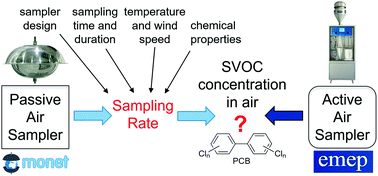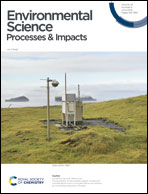Comparability of semivolatile organic compound concentrations from co-located active and passive air monitoring networks in Europe†
Abstract
Passive air sampling (PAS) has been used to monitor semivolatile organic compounds (SVOCs) for the past 20 years, but limitations and uncertainties persist in the derivation of effective sampling volumes, sampling rates, and concentrations. As a result, the comparability of atmospheric levels measured by PAS and concentrations measured by active air sampling (AAS) remains unclear. Long-term PAS data, without conversion into concentrations, provide temporal trends that are similar to, and consistent with, trends from AAS data. However, for more comprehensive environmental and human health assessments of SVOCs, it is also essential to harmonize and pool air concentration data from the major AAS and PAS monitoring networks in Europe. To address this need, we calculated and compared concentration data for 28 SVOCs (including organochlorine pesticides (OCPs), polychlorinated biphenyls (PCBs), polybrominated diphenyl ethers (PBDEs), and polycyclic aromatic hydrocarbons (PAHs)) at the six monitoring sites in Europe with 10 years of co-located AAS (EMEP) and PAS (MONET) data: Birkenes, Košetice, Pallas, Råö, Stórhöfði, and Zeppelin. Atmospheric SVOC concentrations were derived from PAS data using the two most common computation models. Long-term agreement between the AAS and PAS data was strong for most SVOCs and sites, with 79% of the median PAS-derived concentrations falling within a factor of 3 of their corresponding AAS concentrations. However, in both models it is necessary to set a sampler-dependent correction factor to prevent underestimation of concentrations for primarily particle-associated SVOCs. In contrast, the models overestimate concentrations at sites with wind speeds that consistently exceed 4 m s−1. We present two recommendations that, if followed, allow MONET PAS to provide sufficiently accurate estimates of SVOC concentrations in air so that they can be deployed together with AAS in regional and global monitoring networks.

- This article is part of the themed collection: Recent Open Access Articles


 Please wait while we load your content...
Please wait while we load your content...